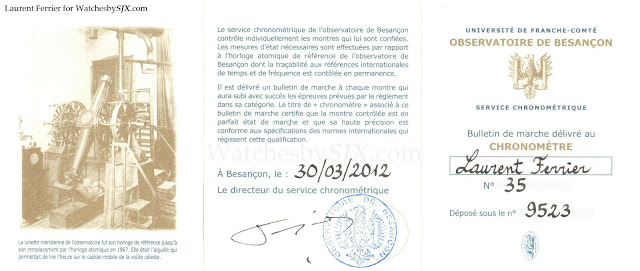How important is accuracy?

Laurent Ferrier recently announced that one of its sublime Galet Classic Tourbillons, serial no. 35 to be specific, achieved a superb average daily variation of just 1.29 seconds at the Besançon Observatory timing test. This makes it the best performing chronometer certified at Besançon since 2006.
| The certificate for the Laurent Ferrier |
And last year the Concours de Chronométrie contest was topped by Greubel Forsey and surprisingly Tissot, in their respective categories.
That brings me to the question – how important is timekeeping?
For me personally, anything below +/- 10 seconds a day is perfectly acceptable, maybe even a bit more. That is generous, I know there are collectors who obsess over +/- 1 second variation. Earlier on in my collecting I obsessively checked the variation on each of my watches and even contemplating buying a timing machine. But that phase passed many years ago. Now I am not exceptionally picky about timekeeping in general. That’s mainly for practical reasons; I typically don’t wear a watch continuously for long enough for it to accumulate a significant variation. Measuring the daily variation of watches is like the performance of supercars, where the fraction of a second shaved off the 0-100 km/h sprint is something to boast about. But practically speaking it is quite meaningless, unless the variation adds up to minutes a week. I prefer to take a wider view of movements rather than focusing on timekeeping. My view is that a well designed and constructed movement will, on average, keep better time than a badly executed calibre. The exceptional timekeeping like that achieved by the Laurent Ferrier no. 35 is due to special care in adjustment as well as some luck. Of course this was possible because the calibre is an excellent one in the first place. So for me personally it is more important to search for superb calibres, rather than specific examples of superb timekeepers. The Laurent Ferrier no. 35 or any other super well adjusted watch will not keep the same time after several years or an overhaul. Those timing results are transient things.
– SJX
Back to top.